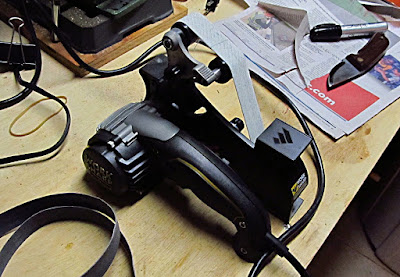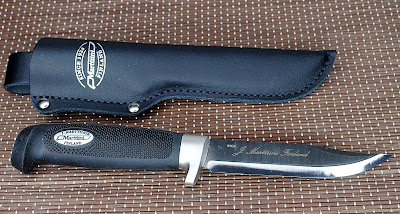Ken Onion made his first knife in
1991 and hasn’t looked back. He is a prodigious
innovator holding 36 design patents on different items including locks,
mechanisms, and knife designs.
 |
| Ken Onion Designed Rain Paring Knife |
And frankly, I really love his
designs. So when I had the chance I picked
up a kitchen knife from his Rain collection from Chef Works. The instantly visible, the most striking
aspect of the knife is the highly polished blade with a textured rain drop
pattern. Hence the name. The pattern on the blade is designed to
reduce food drag caused by surface tension and drag coefficient by creating
multiple pockets of air.
Beats me. I know drag coefficient is used in
calculating friction forces which resist movement. I’m sure if you spent 8 hours
a day cutting food, you’d want reduced food drag too!
 |
| The blade is on top |
The business end is a 3 inch
reverse paring blade made from Carpenter’s DBZ-1 stainless steel.
DBZ-1 isn’t made from exotic
elements. The bulk of it is iron. Carbon is between 0.6 and 0.75% with chromium
falling in line with 12.5 to 15.3%.
There’s only 0.75% molybdenum and
a smattering of other elements. The key
to this martensitic steel is that it is designed to produce a network of fine carbide
particles throughout the steel. This
produces a steel that takes a remarkable edge and holds it.
The most interesting part is the reverse edge. The curved blade has the sharp, business edge
on the top of the blade. You need to be
careful gripping the knife, because the finger grooves are on the opposite side
from the edge. I can’t tell you how many
times I wanted to put my thumb on the razor sharp edge. Just be real careful with this one.
 |
| They even warn you in the box. |
The handle is shaped from G-10, a
high-pressure fiberglass laminate. It is
made by stacking multiple layers of epoxy resin soaked fiber glass sheets and
curing under high compression. G-10 is
the toughest of the glass fiber resin laminates. It is almost indestructible.
This is a glamorous knife. The blade catches the light and winks as you
move it. The handle with it’s finger
grooves feel really good. It was Blade magazine’s
Kitchen Knife of 2013.
But you better watch that
blade. You may not shoot your eye out,
but you’ll cut you finger off.















